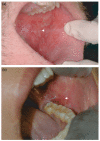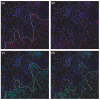Oral graft-versus-host disease
- PMID: 18593456
- PMCID: PMC2565862
- DOI: 10.1111/j.1601-0825.2008.01448.x
Oral graft-versus-host disease
Abstract
Objective: Graft-versus-host disease (GVHD) is a leading cause of morbidity and mortality in patients receiving hematopoietic cell transplant. It is estimated that 40-70% of engrafted patients surviving the initial transplant eventually develop chronic GVHD (cGVHD), which can persist for months to years and require long-term management from multiple disciplines. This review describes the oral component of this transplant complication.
Design: The search related to GVHD patho-biology, salivary gland disease after hematopoietic cell transplant and treatments for oral GVHD encompassed literature from 1966 through 2008. Searches were limited to the MEDLINE/PubMed database and English language literature in peer-reviewed journals.
Results: Our understanding of the patho-biology of oral cGVHD is based on studies of other affected tissues. It is difficult to determine the prevalence and incidence of salivary gland disease after transplant because there is no universally accepted case definition. In general, clinical trials for treatment of oral cGVHD have been too small to make strong recommendations for use in clinical practice.
Conclusions: Larger well-designed clinical studies are needed to understand the patho-biology of oral cGVHD and determine best treatments for this disease.
Figures



References
-
- Agha-Hosseini F, Mirzaii-Dizgah I, Ghavamzadeh L, Ghavamzadeh A, Tohidast-Acrad Z. Effect of pilocarpine hydrochloride on unstimulated whole saliva flow rate and composition in patients with chronic graft-versus-host disease (cGVHD) Bone Marrow Transplant. 2007;39:431–434. - PubMed
-
- Albert MH, Becker B, Schuster FR, et al. Oral graft vs. host disease in children – treatment with topical tacrolimus ointment. Pediatr Transplant. 2007;11:306–311. - PubMed
-
- Alborghetti MR, Correa ME, Adam RL, et al. Late effects of chronic graft-vs.-host disease in minor salivary glands. J Oral Pathol Med. 2005;34:486–493. - PubMed
-
- Appelbaum FR. Hematopoietic-cell transplantation at 50. N Engl J Med. 2007;357:1472–1475. - PubMed
Publication types
MeSH terms
Grants and funding
LinkOut - more resources
Full Text Sources
Medical

